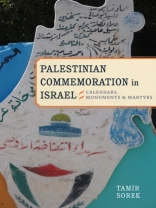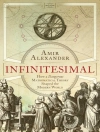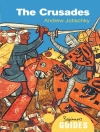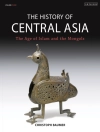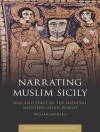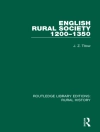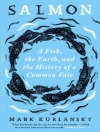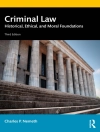Collective memory transforms historical events into political myths. In this book, Tamir Sorek considers the development of collective memory and national commemoration among the Palestinian citizens of Israel. He charts the popular politicization of four key events—the Nakba, the 1956 Kafr Qasim Massacre, the 1976 Land Day, and the October 2000 killing of twelve Palestinian citizens in Israel—and investigates a range of commemorative sites, including memorial rallies, monuments, poetry, the education system, political summer camps, and individual historical remembrance. These sites have become battlefields between diverse social forces and actors—including Arab political parties, the Israeli government and security services, local authorities, grassroots organizations, journalists, and artists—over representations of the past.
Palestinian commemorations are uniquely tied to Palestinian encounters with the Israeli state apparatus, with Jewish Israeli citizens of Israel, and by their position as Israeli citizens themselves. Reflecting longstanding tensions between Palestinian citizens and the Israeli state, as well as growing pressures across Palestinian societies within and beyond Israel, these moments of commemoration distinguish Palestinian citizens not only from Jewish citizens, but from Palestinians elsewhere. Ultimately, Sorek shows that Palestinian citizens have developed commemorations and a collective memory that offers both moments of protest and points of dialogue, that is both cautious and circuitous.
Mục lục
Contents and Abstracts
Introduction
chapter abstract
The chapter demonstrates the centrality of commemoration as a form of political protest among Palestinian citizens, as well as the historical link between this commemoration and the adoption of Israeli citizenship as part of their identity. It argues that Palestinian commemoration in Israel is both a stage for displaying Palestinian national pride and a mobilizing vehicle for struggle over civil equality, and its content is shaped to a large extent by the tension between these two goals. The chapter contextualizes the study in the relevant literature on collective memory and explains the unique case of the Palestinians citizens of Israel compared with other ‘trapped’ minorities. Finally, the chapter outlines the methodology used in the book.
1
Commemoration under British Rule
chapter abstract
The chapter explores how political calendars and shared martyrology provided important markers of identity and symbolic tools for political mobilization in Mandate Palestine. The dates on the emerging Palestinian calendar grew out of the politicization and nationalization of traditional holy days, as well as the commemoration of politically significant events of the period, including those involving local Palestinian martyrs. Commemorative events were especially important for the advancement of Palestinian particularism, which could not rely on a distinct language and culture or a common religion. Although the Palestinian elite was well aware of the importance of these markers to identity formation, its ability to nurture them was limited by institutional weakness, lack of political sovereignty, and British antagonism to this commemoration.
2
The Kafr Qasim Massacre and Land Day
chapter abstract
The Kafr Qasim massacre in 1956 was only one out of several massacres committed against Palestinians in the same historical period. The selection of the event into the political calendar of the Palestinians in Israel and the endurance of its commemoration are related to the status of the victims and commemorators as Israeli citizens. The commemoration of the massacre has been influenced by the need to prevent its reoccurrence and therefore the emphasis on civil rights has been a central discursive tool. From 1976, Land Day was added as a second anchor on the political calendar. Land Day commemoration has been shaped by the tension between Palestinian nationalism and a struggle for civic equality. Until the 1990s, the Israeli Communist Party has dominated the commemoration of both events, and accordingly, the status of Jewish citizens as speakers, chorographers, and potential audience had been salient.
3
The Political Calendar in the Twenty-First Century
chapter abstract
The twenty-first century has witnessed the addition of two dates to the political calendar of the Palestinians in Israel—a memorial day for the Nakba and al-Aqsa Day, commemorating the events of October 2000 during which Israeli police killed thirteen Palestinians inside Israel. Both events have become a sphere of contention not only between Palestinian citizens and the state but also between religious and secular forces within Palestinian society, which even commemorate the Nakba in different days. The October 2000 events have pushed Palestinians in Israel to reconsider the meaning of citizenship, not necessarily to withdraw from a shared Israeli public sphere, and this complicated approach is reflected in all the four major commemorations on the political calendar.
4
Memorials for Martyrs, I (1976-1983)
chapter abstract
Memorial monuments have been added to commemorative repertoire of Palestinians in Israel since 1976. This chapter begins by explaining the delay in their appearance. In the first wave of commemoration (1976-1983), six monuments were built, which reflected the high level of caution practiced by their creators. The caution was expressed by locating some of these monuments in cemeteries rather than in central visible sites, by inscribing sanitized text on the monuments that did not identify a perpetrator, by including Jewish citizens as creators or commemorated subjects, by avoiding explicit contextualization of the commemoration in the broader Palestinian national narrative, and by emphasiziing loyalties that were considered less political such as local, religious, and communal identities.
5
Memorial Monuments for Martyrs, II (1998-2013)
chapter abstract
A second wave of monuments began slowly in 1998, to commemorate the fiftieth anniversary of the Nakba, and it drastically increased following October 2000. The monuments in this wave reflected a limited decline in caution and self-censorship, expressed not only by the number of monuments, but also by their location in highly visible sites. In addition, there was a mildly growing tendency to frame local pride as an aspect of national pride, and a decline in the attempts to use localism as a protective measure from the state’s antagonism to Palestinian national identity. This trend was expressed unevenly across different localities, and old prudent tactics were still evident, especially around monuments referring to 1948. In addition, Palestinians who were not citizens were mostly excluded from the monuments.
6
On the Margins of Commemoration
chapter abstract
Beyond the canonic events on the political calendar, the historical remembrance of Palestinians in Israel includes many other dates and events situated in various degrees of distance from the core of the cannon. Some events have been commemorated mainly locally, without continuous cross-regional participation; others mostly by a specific party or movement; still other commemorations have been limited to press coverage, and the memory was not embodied by mass rallies; or the embodied commemoration in the form of mass rallies did not last more than a decade. There are three major dimensions of marginalization. First, temporal – teaching pre-1948 Palestinian history is an intellectual project with marginal public resonance so far; second, thematic, Palestinians in Israel have remained at a safe distance from the armed struggle, especially if it targeted civilians; third, geo-political, Palestinians who are not citizens of Israel have been extremely marginal in the public commemoration.
7
Disciplining Palestinian Memory
chapter abstract
The anxiety of the Jewish public in Israel regarding the public appearance of a Palestinian national narrative has led to continuous attempts to discipline the public display of Palestinian political memory. In the rst decades after 1948 this discipline was imposed mainly by strict monitoring by the security services. As the Jews’ siege mentality abated and Arab self-condence and organizational ability increased in the 1980s and 1990s, elements of the Palestinian national narrative gained more public visibility. From 2000, the Second Intifada reversed the abating anxiety, but it was too late to restore the old modes of disciplining memory. In the new era, disciplining memory is based on a combination of restrictive legislation, public intimidations by government ofcials, and the watchful civic gaze of ordinary citizens. These modes are not completely ineffective but they are far from pushing national historical remembrance back to the private sphere.
8
The Struggle over the Next Generation
chapter abstract
The official curriculum in Israeli schools has long excluded the Palestinian national narrative. The chapter presents evidence that although Palestinians in Israel do not tend to see the formal education system as a main source of their historical knowledge, this system is still influential in shaping historical remembrance. Given the uniqueness of public education as an extremely imbalanced political battlefield, activists, educators, and parents developed diverse tools aimed to bypass, alter, or confront the curriculum of the formal education system. The chapter discusses some of these tools, including increasing the role of private schools, developing alternative teaching materials, and disseminating these materials either inside the public education system or thorough extracurricular activities.
9
Political Summer Camps
chapter abstract
Summer camps became an important element in the alternative education system of the Palestinian citizens of Israel, and a space for processing national memory and transmitting it to children. All major parties and movements organize summer camps, in which the development of collective memory has a central place. Themes banned at school are openly discussed in an environment considered relatively safe. At the same time Israeli state agencies, through trial and error tactics, check the limits of their ability to monitor and discipline the curriculum of these camps. Summer camps, however, are not equivalent to a mandatory education system. The ability of Palestinian agents of memory to inculcate their own version of history to the next generation is limited as they lack the coercive power of a central government that can impose universal ‘required knowledge.’
10
The Quest for Victory
chapter abstract
The chapter examines the semiotic structure of Palestinian collective memory in Israel and identifies a continuous tendency to balance themes of victimhood with themes of prowess. Modern Palestinian and Arab histories make themes of victimhood significantly more available and the frequent attempts to construct various events as victories is a common thread that links the ‘literature of resistance’ under the military regime, with the widespread satisfaction from the Israeli failure in Lebanon in 2006. The attraction to triumphal themes is even more evident among those Arab citizens who define themselves as both Palestinians and Israelis, probably because Israeli defeats at the hands of Arabs pave the way for imagining a more egalitarian interaction with Jews.
11
Latent Nostalgia to Yitzhak Rabin
chapter abstract
As one of the major figures responsible for the Nakba, the way the late Prime Minister Yitzhak Rabin is remembered by Palestinian citizens of Israel after his assassination in 1995 is a very good example for a strategic suspension of the Nakba memory. The chapter suggests the existence of a latent nostalgia for Rabin’s second term as prime minister (1992–1995) as a period when being Israeli looked like a realistic option for Palestinian citizens of Israel. This nostalgia is ‘latent’ because in the post-2000 era it can be found only in responses of individuals to a survey questionnaire, but not in the public sphere.
Conclusion
chapter abstract
The chapter identifies the tension between being Palestinian and being an Israeli citizen as a major force that shapes Palestinian commemoration in Israel. While some other axes of conflict (integration-separation; local-national; elite-masses; intra-Palestinian communal relations) are not simple derivative of this tension, they are commonly related to it in one way or another. Together, these tensions create frequent discrepancies between various forms and spheres of historical remembrance and commemoration, as well as internal inconsistencies in the commemorative rhetoric.
Giới thiệu về tác giả
Tamir Sorek is Associate Professor of Sociology and Israel Studies at the University of Florida. He is the author of
Arab Soccer in a Jewish State: The Integrative Enclave (2007).
